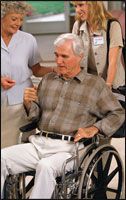Publication
Article
Pharmacy Times
coagulation counseling
Author(s):
PRASUGREL TRIALYIELDS MIXEDRESULTS
Results of a pivotal trial comparingprasugrel with clopidogrel demonstrateda reduced rate of ischemicevents in patients who received prasugrelafter percutaneous coronaryintervention (PCI). The prasugreltreatedgroup experienced higherrates of bleeding, however, includingfatal bleeding.
The study of 13,608 moderate-tohighrisk patients scheduled for PCIcompared a regimen of prasugrel(60-mg loading dose and 10-mg dailymaintenance dose) with clopidogrel(300-mg loading dose and 75-mgdaily maintenance dose) given for 6to 15 months. The primary efficacyend point was death from cardiovascularcauses, nonfatal myocardialinfarction, or nonfatal stroke. Thekey safety end point was majorbleeding.
The primary efficacy end pointoccurred in 12.1% of patients receivingclopidogrel and 9.9% of patientsreceiving prasugrel. Significant reductionsoccured in the prasugrelgroup in the rates of secondary endpoints. Major bleeding was observedin 2.4% of patients receiving prasugreland in 1.8% of patients receivingclopidogrel. Also greater in the prasugrelgroup was the rate of lifethreateningbleeding.
Publication of these results comeson the heels of the suspension of 2small, early-phase clinical trials ofprasugrel because of concerns relatedto the need for dosing adjustmentsin certain populations. Themanufacturer, Eli Lilly and Co, expectspatient enrollment to resumeonce the protocols are amendedand approved by institutional reviewboards.
ASPIRIN EFFECT RELATED TO GENDER

Aspirin is commonly used to reduce the risk of heart attacks, buttrials examining its efficacy have yielded varying results. A recentmeta-analysis of clinical trials of aspirin for primary and secondarymyocardial infarction (MI) prevention suggests that differences inefficacy may be explained by gender.
Twenty-three trials (n = 113,494 participants) were identified.Overall, compared with placebo, aspirin reduced the risk of nonfatalMI but not fatal MI. A total of 27% of the variation in the nonfatalMI results could be accounted for by considering the gender mix of the trials.Trials that recruited predominantly men demonstrated the largest risk reduction innonfatal MI, whereas trials that contained predominantly women failed to demonstratea significant risk reduction in nonfatal MI. The authors concluded that genderaccounts for a substantial proportion of the variability in the efficacy of aspirin inreducing MI rates across these trials.
THROMBOEMBOLISM RISK LOW WITH WARFARININTERRUPTION
Temporary interruption of warfarin therapy for invasive procedures does not appearto pose a significant risk of thromboembolism. In a recent study of 1024 patients,warfarin was withheld for varying periods (usually .5 days). Perioperative bridgingtherapy with heparin or low-molecular-weight heparin was used in 8.3% of cases.
Seven of 1024 patients, none of whom received bridging therapy, experienced athromboembolic event within 30 days of their procedure. Six patients experiencedmajor bleeding, whereas an additional 17 patients experienced clinically significant,nonmajor bleeding. Of these 23 patients, 14 received periprocedural heparin or lowmolecular-weight heparin. The authors concluded that the risk of thromboembolismis low with warfarin interruption and that this risk should be weighed against the riskof bleeding before administration of bridging therapy.
CARE DECLINES AFTER RELEASE FROM CLINICS

A recently published study determined that transitioning patientsfrom a pharmacist-managed anticoagulation clinic afterstabilization of warfarin therapy to physician-managed care hada negative effect on anticoagulation care. Forty patients whowere stable on warfarin therapy were included in a retrospectivereview of their care. Quality of anticoagulation care wasmeasured by the percentage of international normalized ratios(INRs) in target range, anticoagulation-related health care visits,and responses to surveys.
A decrease in anticoagulation control was observed ontransition to physician-managed care. Prior to the transition,76% of all INRs were in target range, versus 48% after transition.The number of INRs obtained that were >4.5 and <1.5 also was significantlyhigher. The number of emergency department (ED) or office visits related to anticoagulationwhile under a pharmacist's care was very low (2) but increased to 13 (7 office visits, 6 ED visits) after patients were discharged back to their physician. Noneof the episodes resulted in hospitalization. Patient satisfaction with clinical care providedby the anticoagulation clinic was significantly higher before transition.







